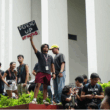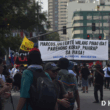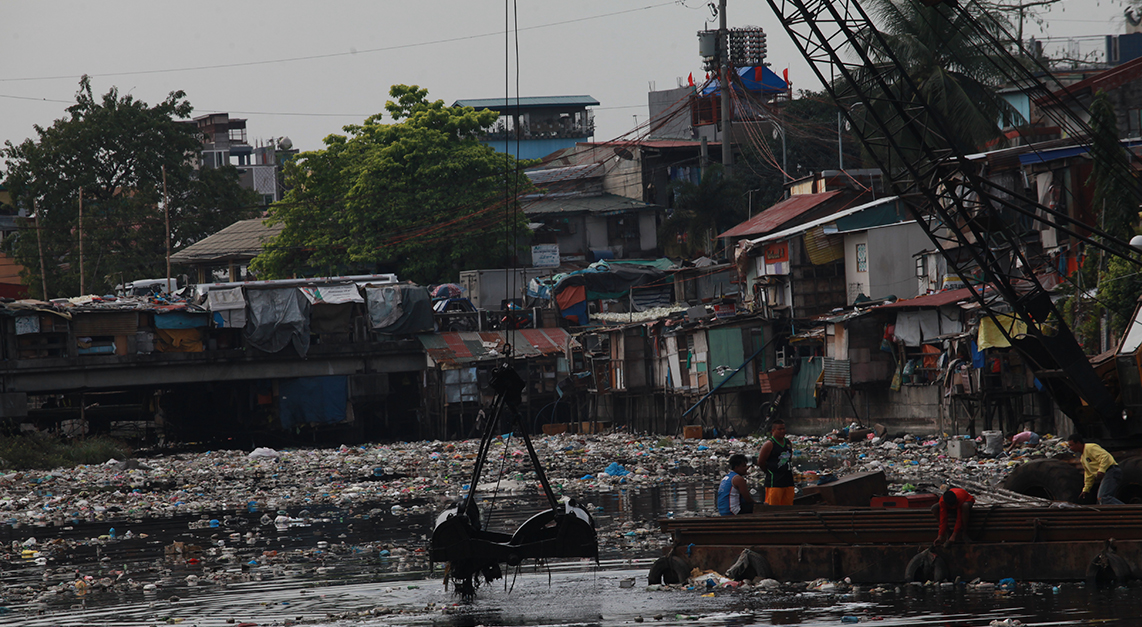President Ferdinand Marcos Jr. raised eyebrows after touting the “completion” of over 5,500 flood control projects during his State of the Nation Address last July 22. More projects are underway nationwide, he said.
But his claims were called into question when Super Typhoon Carina (international name: Gaemi) struck just days later, submerging parts of Metro Manila in floodwaters. More than a month later, Severe Tropical Storm Enteng (Yagi) ravaged the national capital region together with the southwest monsoon (habagat).
The pressing need for flood control measures fueled public discourse about whether or not the multi-billion-peso projects funded in recent years were effective in managing the heavy flooding in the metropolitan region. Some netizens have also cast their doubts on their existence and progress.
“Anong nangyari sa daan-bilyon na flood control projects ng DPWH, MMDA at mga lokal na pamahalaan?” Senate President Chiz Escudero asked.
Part of Department of Public Works and Highways’ (DPWH)’s flood management program is the Metro Manila Flood Management Project (MMFMP) Phase 1, whose implementation has been ongoing since the Duterte administration in March 2018.
This project is the first phase of the broader flood management master plan the agency crafted in early 2010s for Metro Manila and surrounding areas in light of the onslaught of Ondoy (Ketsana) and Pepeng (Parma) in 2009. The National Economic and Development Authority (NEDA) approved the roadmap on Sept. 4, 2012.
In February 2015, the Australia-World Bank Philippines Development Trust Fund and Policy and Human Resources Development Trust Fund of Japan gave the World Bank a USD 7-million grant to finance studies and designs of other interventions for the next phase of the master plan implementation.
The MMFMP aims to improve flood management in the metropolis by upgrading drainage infrastructure, reducing solid waste in waterways and resettling informal settler families living in high-risk flood zones.
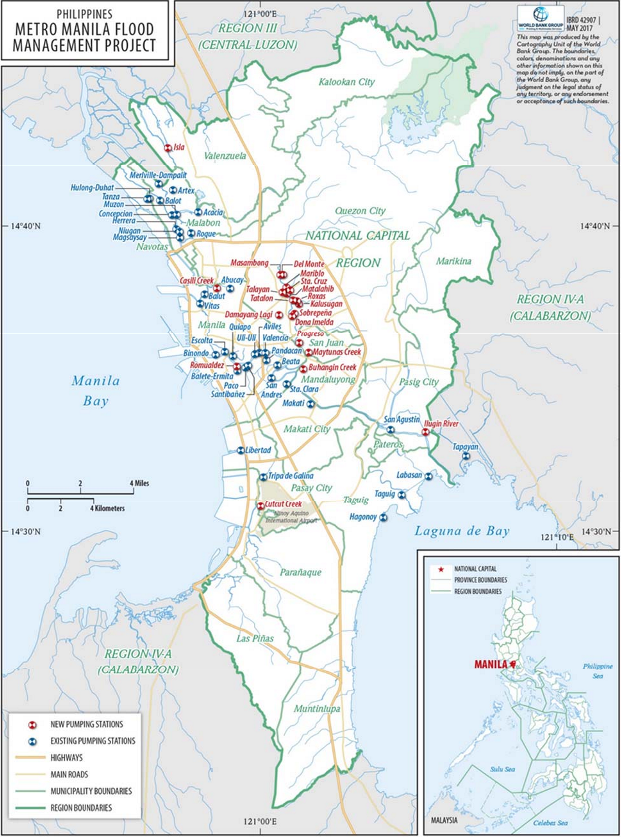
“The Master Plan will take 25 years to implement, but this phase of modernizing Metro Manila’s pumping stations will ensure that several million residents will be less vulnerable to floods,” former DPWH Secretary Sen. Mark Villar was quoted in a Sept. 29, 2017 press release.
The USD 500-million project is mostly funded by foreign loans. The World Bank, through its lending arm the International Bank for Reconstruction and Development, and the China-based Asian Infrastructure Investment Bank (AIIB) is providing worth USD 207.6 million.
The Philippine government, meanwhile, will provide the remaining USD 84.79 million for the project.
| Project Components | Cost | Financing | ||
| AIIB | WB-IBRD | PH gov’t | ||
| 1: Modernizing Drainage Areas | 375.20 | 168.84 | 168.84 | 37.52 |
| 2: Minimizing Solid Waste in Waterways | 48.00 | 21.60 | 21.60 | 4.80 |
| 3: Participatory Housing and Resettlement | 55.75 | 7.64 | 7.64 | 40.47 |
| 4: Project Management and Coordination | 20.00 | 9.00 | 9.00 | 2.00 |
| Total Direct Project Cost | 498.95 | 207.08 | 207.08 | 84.79 |
| Front-end Fee | 1.04 | 0.52 | 0.52 | 0.00 |
| Total Overall Cost | 500.00 | 207.60 | 207.60 | 84.79 |
The two financial institutions approved their loan commitments in September 2017, with both loans expecting to close on Nov. 30.
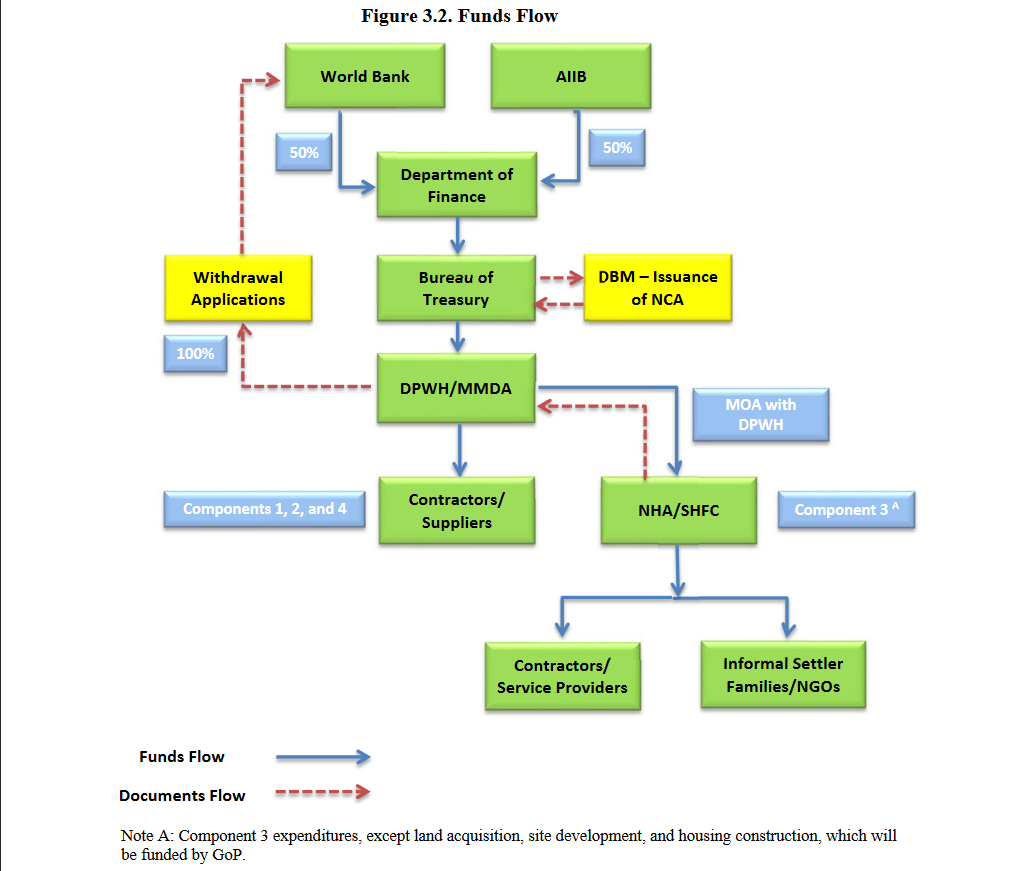
The MMFMP’s first component involves the modernization of 36 existing pumping stations (PS) in Metro Manila, most of which were built in the 1970s. It also covers the construction of 20 new stations and the improvement of supporting infrastructure along critical waterways and drainage channels in the cities within the region.
Most of the included stations are in Manila (17 subprojects), Quezon City (13) and Malabon (12).
According to the progress report submitted to the World Bank on March 27, five stations out of 25 with known status have been successfully rehabilitated/upgraded. Most rehabilitation subprojects are either underway or have been awarded, the report read.
The said pumping stations are as follows:
- Balut PS (Tondo, Manila)
- Labasan PS (Napindan, Taguig)
- Vitas PS (Tondo, Manila)
- Paco PS (Paco, Manila), completed by April
- Sta. Clara (Sta. Ana, Manila), completed by April
Works in Libertad, Makati, Acacia, Niugan and Muzon PS are ongoing, a December 2023 progress report from AIIB read.
Meanwhile, of the 20 new PS queued for construction, five were dropped due to “expected further delays in land acquisition” such as right-of-way issues.
“The dropping of these [five] new PS and other adjustments in the project budget will result in partial loan cancellation of up to USD 45 million (approximately USD 22.5 million each for AIIB and WB),” the report added.
Delayed for over a year, the MMFMP faced “carried-over” setbacks and bottlenecks due to start-up issues and the COVID-19 pandemic. Works in Balut PS, whose contract expired in January 2020 but was extended to a year, were suspended when Metro Manila was placed on lockdown in March 2020. All other project activities such as procurement were also halted, an Aug. 24, 2020 progress report submitted to the AIIB read.
As of writing, 11 other existing PS have yet to be queued for rehabilitation.
Most construction subprojects have not shown significant progress either. The DPWH only started looking for possible contractors for the construction of four stations in Quezon City (Doña Imelda, Roxas I, Roxas II and Tatalon) from late April to May. Notices of award were only given to winning bidders for their construction earlier this August.
The rest, meanwhile, have yet to appear in any formal bidding notice from the public records of DPWH and World Bank.
With over a month left for the Philippine government to disburse funds from the loan commitment from AIIB and World Bank, MMFMP’s implementing agencies asked to have the loan closing dates extended by two more years (Nov. 30, 2026) to complete all pending subprojects.
This, alongside the partial loan cancellation of USD 45 million as part of their “loan restructuring” request.
“The final NEDA board approval is targeted for early July, while the Department of Finance’s letter for restructuring is expected by the end of July,” the June 2024 AIIB progress report read.
Flood control budget over the years
In the proposed budget for 2025, more than P254 billion was earmarked for DPWH’s flood management program. This exceeds the proposed allotments for entire departments such as the Department of National Defense (P232.2 billion) and the Department of Social Welfare and Development (P209.9 billion).
According to public budget analyst Zy-za “Budget Babe” Suzara, a total of P1.14 trillion has been allocated for flood control projects under DPWH from 2015 to 2024.
From 2022 to 2024 alone, the government has allotted P556.5 billion for flood control. “This is nearly half of the budget of the [allocation] for the last decade,” she noted in a July 26 post on X.
But the MMFMP was never given a chunk of the P244.6 billion flood control budget this year.
The first two years of the Marcos administration was also marked by a significant increase between the proposed and enacted budgets for flood control.
“[The budget] increased by 51B in 2023 GAA vs proposed level and increased 28.9B in the 2024 GAA vs proposed level,” Suzara said.
“Flood control is definitely not underfunded, but are we seeing results?”

Deep Watch, formerly JC Reports, is UP Journalism Club’s official investigative reporting arm. Here, we dig deeper into issues where truth runs deep.



